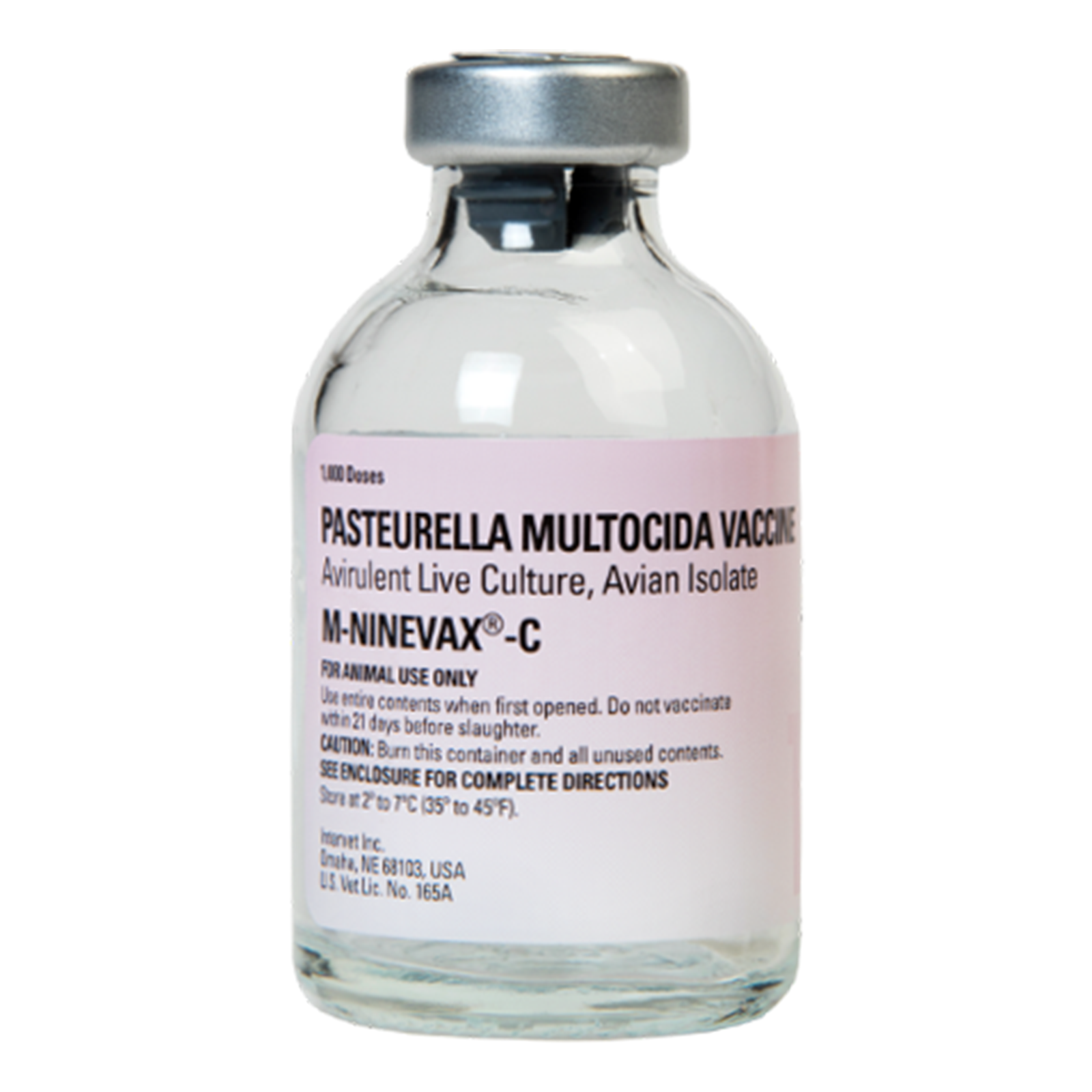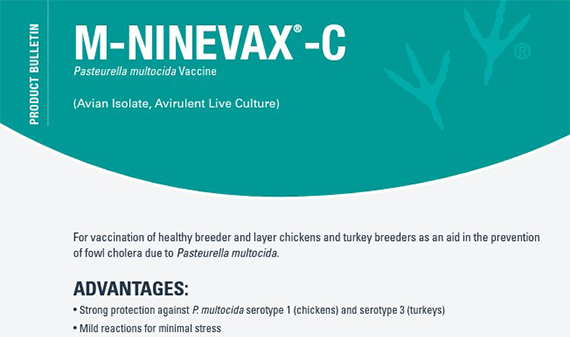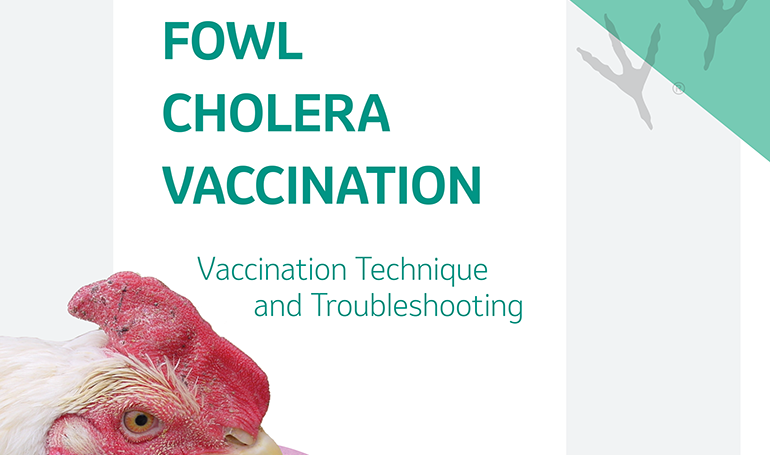
M-NINEVAX®-C
Pasteurella multocida Vaccine
Product Description
M-NINEVAX-C vaccine is a live bacterial vaccine containing the mild avirulent M-9 strain of Pasteurella multocida, Heddleston Type 3-4 cross, in a freeze-dried preparation sealed under vacuum. The seed culture used to make this vaccine has been laboratory tested for protection in chickens against challenge with the X-73 (Type-1) strain of P. multocida and in turkeys against challenge with the P1059 (Type 3) strain of P. multocida.
Indications
This product has been shown to be effective for the vaccination of healthy chickens 10‑12 weeks of age against pasteurellosis (fowl cholera) due to Pasteurella multocida Type 1 infection and healthy turkeys 6 weeks of age or older against pasteurellosis (fowl cholera) due to Pasteurella multocida Type 3 infection.
Advantages*
- Strong protection against P. multocida serotype 1 (chickens) and serotype 3 (turkeys)
- Mild reactions for minimal stress
- SAFE. Avirulent live culture will not revert to virulence; will not cause mortality
- Specially formulated diluent provides excellent reconstitution stability
Diseases/Parasites
- Pasteurella multocida – Fowl cholera
When To Vaccinate
BY WING-WEB:
Chickens: Use by wing-web stab to vaccinate chickens 10-12 weeks of age and again at 18-20 weeks of age as an aid in the prevention of pasteurellosis (fowl cholera) due to P. multocida Type 1. There should be at least 6 weeks and not more than 10 weeks between vaccinations.
Turkeys: Use by wing-web stab to vaccinate turkey breeders 15 weeks of age or older as an aid in the prevention of pasteurellosis (fowl cholera) due to P. multocida Type 3. Birds should initially be wing-web vaccinated at 15-18 weeks of age and again 8 weeks later. Turkey breeders must be vaccinated at least twice with live fowl cholera vaccine via oral route prior to wing-web vaccination. The interval between the last oral vaccination and the first wing-web vaccination should not exceed 6 weeks. Additional wing-web vaccination every 6-8 weeks throughout the life of the bird may be required in areas of endemic exposure to fowl cholera.
BY DRINKING WATER:
Turkeys: Best results are obtained when vaccine is administered initially to turkeys 6 to 8 weeks of age, followed by a booster dose three weeks later, and repeated every 4 to 6 weeks thereafter as necessary according to exposure conditions.
Vaccination Programs
Many factors must be considered in determining the vaccination program for a particular farm or poultry operation. To be fully effective, the vaccine must be administered to healthy receptive birds held in proper environment under good management. In addition, the response may be modified by the age of the birds and their immune status. Seldom does 1 vaccination under field conditions produce complete protection for all individuals in a given flock. The amount of protection required will vary with the type of operation and the degree of exposure that a flock is likely to encounter.
Contraindications
FOR WING-WEB VACCINATION:
Chickens: Initial vaccination in chickens over 12 weeks of age may be undesirable because larger granulomas may develop at the site of inoculation and this may result in downgrading of carcasses at slaughter.
Turkeys: Use of this vaccine in turkeys which have not been orally prevaccinated may cause severe postvaccination reactions, including lameness and death.
FOR DRINKING WATER VACCINATION:
Turkeys: Must be healthy and free of environmental or physical stress at the time of vaccination. Initial vaccination with this vaccine should not be conducted in turkeys older than 12 weeks of age. Do not use this vaccine within 2 weeks before or 2 weeks after vaccinating turkeys with live virus Newcastle vaccine.
How To Vaccinate
BY WING-WEB METHOD:
- Vaccination is accomplished by dipping the needle applicator into the mixed vaccine and piercing the webbed portion of the underside of the wing. Avoid piercing through feathers which may wipe off the vaccine and avoid hitting the wing muscle or bone to minimize reaction. The applicator is designed to pick up the proper amount of vaccine on the needles, which is deposited in the tissues when the wing is pierced.
- Redip the applicator in the vaccine before each application. Excess vaccine adhering to the applicator should be removed by touching the applicator to the inside of the vial.
- At 5 to 10 days following vaccination, a swelling of the skin (subcutaneous granuloma) will develop on the wing‑web at the point of inoculation. The absence of this local reaction may mean that improper vaccination methods were used. Examination for these “takes” at 7 days post-vaccination may be used to assure that proper vaccination has been conducted.
BY DRINKING WATER METHOD:
- Do not use any disinfectants in the drinking water for 48 hours before vaccinating and 24 hours after vaccination.
- Withhold water from the turkeys until they are thirsty.
- Calculate the water volume needed so the vaccine will be consumed in approximately 2 hours.
- Optional: as an aid in preserving the virus, add a vaccine stabilizer to the stock solution or to the tank containing clean, cool, non-chlorinated water. Agitate thoroughly. Follow the manufacturer’s rate of administrations and wait time.
- Add rehydrated vaccine from vial to the water and mix thoroughly.
- Turn on tank valve or automatic dosing system.
- Provide as sole source of drinking water until all vaccine-water solution has been consumed.
Supplied
1 x 1,000 doses
Caution
- VACCINATE ONLY HEALTHY BIRDS.
- All birds should be vaccinated at the same time.
- Do not medicate birds with antibacterial drugs 3 days prior to or 5 days after vaccination.
- Use entire contents when first opened. 5. Do not vaccinate within 21 days before slaughter.
- Store vaccine at 2° to 8° C (35° to 46° F). 7. Inactivate unused contents before disposal.
- Do not mix with other products, except as specified on this label.
- In case of human exposure, contact a physician.
- FOR ANIMAL USE ONLY.
Notice
This vaccine has undergone rigid potency, safety and purity tests, and meets Merck Animal Health, U.S. and local regulatory requirements. It is designed to stimulate effective immunity when used as directed, but the user must be advised that the response to the product depends upon many factors, including, but not limited to, conditions of storage and handling by the user, administration of the vaccine, health and responsiveness of the individual chickens and the degree of field exposure. Therefore, directions should be followed carefully. A safety data sheet (SDS) is available upon request. This and any other consumer information can be obtained by calling Merck Animal Health Customer Service at 1-800-211-3573.
Records
Keep a record of vaccine, quantity, serial number, expiration date, and place of purchase; the date and time of vaccination; the number, age, breed, and locations of chickens; names of operators performing the vaccination and any observed reactions.
Contact our sales or technical services representatives to help design a custom vaccination program.
Resources
For additional information, please see the product label.
For more information regarding efficacy and safety data, go to productdata.aphis.usda.gov.
*Data on file, Merck Animal Health

To view our complete product lineup, click to view our
POULTRY PRODUCT CATALOG vol. 3.1.


